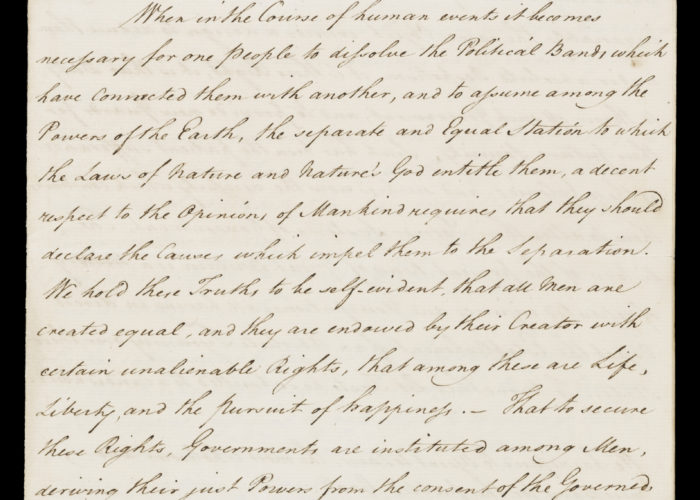Handwritten declaration of American Independence
Theme: American war of independence (1775 - 1783), Political Revolution, American revolution
In the 1700s Britain controlled and governed extensive areas in the Americas and the Caribbean within its empire. In 1776, thirteen of the colonies in North America came together to reject British rule and the sovereignty of King George III over them, and to declare themselves independent states. This was formalised in the Declaration of Independence, the first step towards establishing a new nation – the United States of America. This handwritten version is thought to be one of the very first to reach Britain.
The Declaration of Independence was drafted mainly by Virginian planter and slaveholder Thomas Jefferson, and ratified on 4th July 1776. It drew on the ideas of Thomas Paine and other European philosophers about natural rights and freedoms. One of its most famous lines states:
“…that all men are created equal, they are endowed by their Creator with certain unalienable Rights, that among these are Life, Liberty and the pursuit of Happiness.”
It goes on to list a series of complaints against King George III explaining why they were justified in breaking ties with Britain. Among the objectionable measures were the punishments imposed on American colonists for their refusal to pay taxes to the British Government. Since they had no representation in the British Parliament, Americans had decided that this body had no legitimate authority over them, and they expressed their rights and sovereignty in new ways as they set up new state governments and later a Federal Constitution based on republican principles (with no monarch).
Britain battled to keep its rule over these colonies in what became known as the American Revolution, but eventually admitted defeat. It finally recognized the independence of the thirteen states in 1783. A new republican nation – the United States of America was established, with George Washington becoming its first president in 1789 – while the British Empire reorganised and invested in new territories, including Canada.
This handwritten copy of the Declaration of Independence was sent to the Earl of Sandwich, First Lord of the Admiralty, and was one of the first reports of American independence to reach Britain. The USA still celebrates Independence Day every year, on 4th July. Other revolutions followed suit in designing their own founding documents such as the Haitian Revolution.
Did you know..?
Once the Declaration of Independence had been written and signed, printer John Dunlap was asked to make about 200 copies to be distributed throughout the colonies. Today, the “Dunlap Broadsides” are extremely rare and valuable: only 26 are known to survive and the latest sold for over $8 million in 2000!
Sources & acknowledgements
This object description and its related educational resources were researched and written by our team of historians and education specialists. For further information see the item’s home museum, gallery or archive, listed above.
-
Did you know..?
Once the Declaration of Independence had been written and signed, printer John Dunlap was asked to make about 200 copies to be distributed throughout the colonies. Today, the “Dunlap Broadsides” are extremely rare and valuable: only 26 are known to survive and the latest sold for over $8 million in 2000!
-
Education overview
You can access a range of teachers resources related to this object and more on our education page.
Please also see our glossary of terms for more detailed explanations of the terms used.
-
Curatorial info
- Originating Museum: National Maritime Museum
- Accession Number: SAN/F/9/16
- Production Date: 16th July 1776
- Material: Parchment, Ink
- Creation Place: USA
- Original record
-
Use this image
You can download this image for personal and educational use but please take note of the license type and rights holder information.
- Rights Holder: National Maritime Museum, Greenwich, London
- License Type: All Rights Reserved



